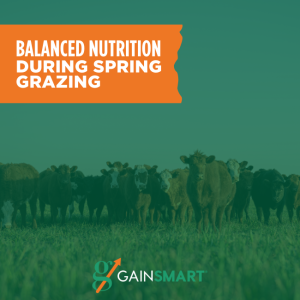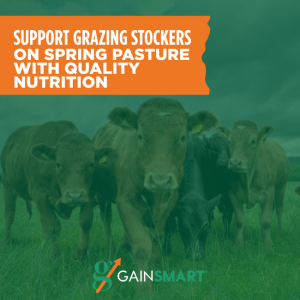
Wheat Pasture
Stockers and backgrounders typically rely on the high-quality nutrients found in wheat pasture to turn their calves out on for late fall and winter grazing. Wheat pasture is an economical source of gain throughout the Southern Plains and Midwest.
Although the wheat hasn’t been planted yet, it will be soon. In typical years, graze-out wheat is planted in early September to give calves the best opportunity for early fall grazing and maximize fall yields. Dual-purpose wheat is usually planted from mid-September through the end of September, while grain-only wheat is planted into October.
So, when will you be able to turn your calves onto wheat pasture? One Kansas State Wheat specialist advises that the wheat should be deeply rooted so cattle won’t pull it out when grazing. Crown root development should exist so as not to pull the plant out. This is why most turn their calved out on wheat pasture in late November or early December.
Cattle Nutrition Experts
Curious about who you’re getting advice from? Gain Smart® is a renowned brand of mineral supplements designed to enhance cattle health, optimize growth and improve feed efficiency. Our products support commercial producers looking to maximize their operations. Best of all, Gain Smart products ensure balanced nutrition for livestock.
The Gain Smart brand is developed by BioZyme® Inc., a leading fermentation company pioneering advancements in animal nutrition and health. Through innovative research and high-quality manufacturing, BioZyme creates powerful solutions that improve animal performance and support producer profitability in the agricultural industry.
Our mission: undeniable positive impact on the health and wellness of your animals and your business.
Benefits of Grazing Wheat Pasture
Grazing calves on wheat pasture provides several advantages to both the cattle and the producer. These benefits can positively impact performance, health and overall productivity. Our BioZyme Team wants to share the benefits with you so you can maximize the potential of your operation.
Improved Weight Gain
Calves grazing on wheat pasture often exhibit higher average daily weight gain (ADG) compared to those on dry forage or other less nutritious pastures. Gains can be substantial, often ranging from 1.5 to 2.5 pounds per day. In addition to an increased ADG, the combination of high protein and energy helps calves grow efficiently, leading to better overall performance and productivity.Cost-Effectiveness
Reduced Feeding Costs
Grazing on wheat pasture can reduce the need for supplemental feeds, lowering overall feeding costs. This is particularly beneficial during the winter months when other forage sources might be less available or more expensive.
Utilizing natural grazing resources can be more economical than purchasing and transporting feed, particularly for large herds.
Health & Nutritional Benefits of Grazing Wheat Pastures
Improved Digestive Health
Grazing on green forage like wheat can promote better digestive health due to the high fiber content, which aids in proper rumen function.
Reduced Disease Risk
Calves on pasture tend to have a decreased risk of certain diseases compared to those in confined feeding operations. The outdoor environment and natural diet help enhance the calves’ immune systems.
High Protein Content
Wheat pasture provides a high level of protein, which is essential for muscle development and overall growth in calves. Protein content in wheat can range from 15% to 30%, depending on the growth stage and environmental conditions.
Energy-Rich
Wheat pasture is also energy-dense, providing the necessary calories for weight gain and maintaining body condition.
Better Use of Land
Grazing wheat pasture allows for the productive use of land that might otherwise lie fallow or be underutilized during certain parts of the year. This can help in maximizing the agricultural productivity of the land.
Grazing can also contribute to soil health by promoting nutrient cycling and reducing the need for chemical fertilizers.
Environmental Benefits of Grazing Wheat Pastures
Erosion Control
Maintaining a vegetative cover on the land through grazing can help reduce soil erosion, especially during the winter and early spring when erosion risks are higher.
Carbon Sequestration
Grazing systems can also contribute to carbon sequestration, helping mitigate greenhouse gas emissions from agriculture.
Flexibility in Management
Wheat pasture can serve dual purposes, providing both grazing for livestock and later harvesting for grain, which can offer flexibility in farm management and income sources.
As you can see there are several advantages to grazing your stockers on wheat pasture from mid-December through mid-March. While grazing wheat for 90 days, you can expect your calves to each gain roughly 180 pounds. At an ADG of 2 pounds per day for 90 days that is 180 pounds of fairly inexpensive gain. If you can extend grazing into April, there is an added 60 pounds of gain.
Challenges of Wheat Pasture Grazing
Although the opportunities for grazing on wheat pasture outweigh the negatives, as with all things, there are still some challenges present when grazing calves on wheat pasture. With proper planning and management, these challenges are manageable to ensure the health and productivity of cattle.
Here are some of the primary considerations:
Nutrient Imbalances
Wheat pasture can be low in magnesium, increasing the risk of grass tetany, especially in lactating cows or fast-growing calves. At the same time, wheat pasture can be high in protein. If you don’t carefully balance that protein with adequate energy, this could cause issues like grass tetany (hypomagnesemia) or bloat.
Providing mineral supplements that include magnesium can help prevent deficiencies and associated health issues. Gain Smart offers a mineral supplement ideal for calves grazing wheat pasture.
Bloat
Wheat pasture, particularly when lush and rapidly growing, can pose a significant risk of bloat in calves. This condition can be fatal if not promptly managed.
Strategies to mitigate bloat include feeding anti-bloat supplements, using ionophores and ensuring cattle have access to dry roughage or other forage types to balance their diet.
Weather Dependence
The success of wheat pasture depends heavily on weather conditions. Drought, excessive rain or untimely frosts can negatively impact pasture availability and quality.
Producers need to be flexible and prepared to adapt their grazing plans based on changing weather patterns and pasture conditions. For instance, too much rain or cold weather early on, can have a negative impact on the ability to successfully graze wheat pasture.
One reason wheat pasture grazing works so well in the Midwest, Southeast and Plains states is because wheat is a commodity that grows well through the winter months.
For instance, due to the dry growing condition, you probably won’t see much wheat grazed in the Southwest. Additionally, the amount of snowfall in the mountain states does not lend itself to fall and winter grazing of wheat pastures either.
Soil & Plant Health
Intensive grazing can lead to soil compaction, which affects soil health and the future productivity of the pasture. Proper management practices, such as rotational grazing and avoiding overgrazing, are necessary to maintain soil and plant health.
Pest & Disease Pressure
Wheat pasture can attract various pests and diseases that may affect both the plants and the grazing cattle. Therefore, producers need to implement integrated pest management strategies to control pests and diseases effectively.
Fencing & Infrastructure
Maintaining secure fencing is essential to keep cattle within designated grazing areas and prevent them from straying, especially in extensive pasture systems.
In addition to having secure fences, cattle need to have continuous access to clean water
While grazing calves on wheat pasture can be highly beneficial, it requires careful management to address the potential challenges. By being aware of these issues and implementing appropriate strategies, producers can optimize the use of wheat pasture to support the health and growth of their cattle.
What is Gain Smart?
Gain Smart is a line of vitamin and mineral supplements for stocker cattle that promotes healthy, economical pounds. Gain Smart offers 4 different free-choice vitamin and mineral supplement formulas to fit any feeding scenario. We even offer one, specially designed for grazing when pasture.
The 4 Gain Smart formulas for stocker cattle include:
- Gain Smart Stocker, designed to maximize efficient gain.
- Gain Smart Stocker Wheat, designed to maximize efficient gain on wheat or small grain pasture.
- Gain Smart Stocker HEAT®, designed to maximize efficient gain when temperatures are above 70 degrees Fahrenheit. Contains HEAT technology, a combination of essential oils and garlic, to support animals when heat and insects are a challenge.
- Gain Smart Stocker Balancer RU1600, designed to maximize efficient gain and balance high grain diets when mixing TMR rations. Includes rumensin for improved feed efficiency.
The Gain Smart Difference
All formulas offer the following key benefits:
- Powered AO-Biotics Amaferm, a prebiotic research-proven to enhance digestibility.
- Include organic copper, iodine, and zinc for maximum bioavailability and hoof health.
- Provide nutritional support for a healthy immune system.
Results Backed by Research
Amaferm, the key ingredient in most of our products, is research-proven to increase digestibility. As a prebiotic, it stimulates the growth of beneficial gut microbes. Research shows that it increases average daily gains by one-quarter (.25) pound per day.
Wouldn’t you like to keep your cattle healthy and increase your calf weight gain per day by one-quarter of a pound just by providing a mineral with Amaferm?
Keep your Calves Healthy on Wheat Pasture!
Have we convinced you that Gain Smart powered by Amaferm is the best supplement for wheat pasture? We hope so! Now that you know about Gain Smart, you can get your calves gaining on wheat pasture today.
Gain Smart is available at one of our local BioZyme Dealers. Locate the dealer nearest you.
Would you like to receive more information about keeping your cattle gaining healthy, efficient pounds? Sign up for our newsletter.

